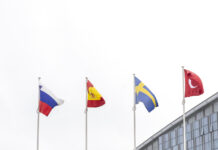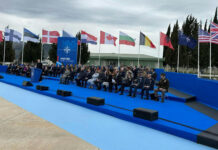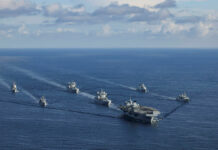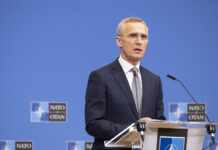As the anniversary of Russia’s invasion of Ukraine on 24 February approaches, the launch in London on 15 February 2023 of The Military Balance 2023 – the annual assessment by the International Institute for Strategic Studies (IISS) of military power around the globe – inevitably had a major focus on the effects of the conflict.
A panel of IISS specialists convened for the launch also discussed other key topics relevant to global military power, most notably China’s ongoing military modernisation and defence spending trends worldwide.
In his opening remarks at the launch Dr John Chipman, IISS Director-General and Chief Executive, assessed Russia’s “ill-judged decision to launch a full-scale invasion of Ukraine” as “a political and military failure”. He noted, however, that the invasion “has recast the security environment in Europe”, that the “geopolitical centre of gravity has moved to the east and to the north”, and that “NATO has found renewed purpose and will almost certainly in 2023 gain two new members in Finland and Sweden”.
Chipman noted that the resilience of Ukraine’s armed forces, leaders and population was vitally supported by Western assistance, both following the Russian February 2022 large-scale invasion and also since Russia’s initial annex by military force of Crimea and eastern Ukraine in 2014. In contrast, he added that Russia’s poor performance on the battlefield has called into question the effectiveness of Moscow’s post-2008 ‘New Look’ military modernisation process. Beyond the lack of effectiveness of Russia’s ground forces, Chipman said “there are also important questions to be raised about aspects of Russia’s naval power and air power. The early loss of the cruiser Moskva was extraordinary, and shortfalls were soon exposed in Russia’s long- and medium-range air-to-surface weapons”.
Russia’s loss of modern main battle tanks (MBTs) is of particular note. Chipman assessed that “around 50% of its pre-invasion fleet of modern T-72B3 and T-72B3M MBTs is assessed to have been lost”, while Russia’s inventory of T-80BV/U tanks “is estimated to have been reduced by two-thirds”.
“Industrial production continues but remains slow,” he said, “forcing Moscow to rely on its older stored weapons as attrition replacements”.
Meanwhile, Ukrainian combat losses led Kyiv to secure supplies of Soviet-era weapons from East European states. However, Chipman observed that, because such stocks are finite, replenishing Ukraine’s war material has led to two other developments. Firstly, Kyiv seeking, and ultimately receiving, weapon systems of Western origin has had a significant effect on the battlefield. Ukraine’s artillery holdings, said Chipman, “are transformative. Western-designed 155 mm guns and rocket artillery mean its army can now strike at long range with more precise projectiles”, an example of the latter being the supply of US M142 High Mobility Artillery Rocket Systems (HIMARS) from mid-2022.
Secondly, said Chipman, the supply of Soviet-era weapons from East European states has accelerated the modernisation of those countries’ armed forces as they replenish their donated equipment with Western-made systems.
However, Chipman noted that Russia has also be reaching further afield for war materiel, with Iran supplying Moscow with armed unmanned aerial vehicles and direct-attack munitions. Chipman suggested that, in return for these weapons, Tehran might receive the Su-35 fighters that Moscow had previously earmarked for Egypt. He added that North Korea is also believed to have provided war materiel to Russia.

Responding to a question from ESD on how The Military Balance has dealt with the rapidly changing military inventories of Russia and Ukraine as a result of the conflict there, the IISS panel acknowledged this was a challenge while noting that some equipment inventories were more difficult to assess than others. For example, the panel noted that, while aircraft numbers and Russia’s holdings of modern MBTs such as the T-72B3 and T-72B3M could be determined to a relatively high degree of accuracy, assessing the number of artillery pieces destroyed/still deployed was much more difficult. In terms of overall Russian losses, the panel acknowledged the gap between the losses determined by open sources and the Russian losses claimed by the Ukrainian Ministry of Defence, assessing that the reality was probably somewhere between the two.
Turning to China, Chipman said that its military modernisation “continues apace. It is building its nuclear capabilities and adding new systems in space, on land, sea and in the air”.
One particular area Chipman highlighted was the transformation of China’s combat aircraft inventory over the last five years. As an example, he said that the Military Balance database now records more than 150 Chinese J-20A fifth-generation fighters. Although Chipman acknowledged that the US Air Force (USAF) is building its inventory of F-35A fifth-generation fighters, which he assessed as now numbering around 360, he warned that “China’s defence-industrial output means it is catching up”. Chipman noted that if deliveries of China’s J-20As continue at the same pace, “in 2023 the number of J-20As will eclipse the inventory of the USAF’s other fifth-generation combat aircraft: the F-22”.
The United States ended production of the F-22 after the last example was delivered in May 2012, capping the F-22 fleet at eight test platforms and 187 operational aircraft. Five F-22s have been lost since the first production aircraft was delivered to the USAF in 2003.
Discussing China’s growing military might, the IISS panel observed that, while the People’s Liberation Army (PLA) had successfully mounted major exercises in recent years, the effectiveness of its command and control capabilities had still not been tested in a high-intensity scenario. Moreover, the continued dominance of China’s ground forces in the PLA hierarchy as a whole might hinder China’s ability to conduct truly joint warfare, the panel suggested.
Regarding defence spending worldwide, the IISS panel noted that Russia’s invasion of Ukraine and perceptions of a potential threat from China in East Asia had pushed defence spending up. However, IISS defence budget specialist Fenella McGerty cautioned that inflationary pressures around the world were meaning that this increased defence spending was generally not leading to any real-term increase in defence spending being realised. This situation has obvious consequences for NATO and its allies in Eastern Europe as they attempt to bolster their armed forces as a deterrent to any further Russian aggression.
Peter Felstead












